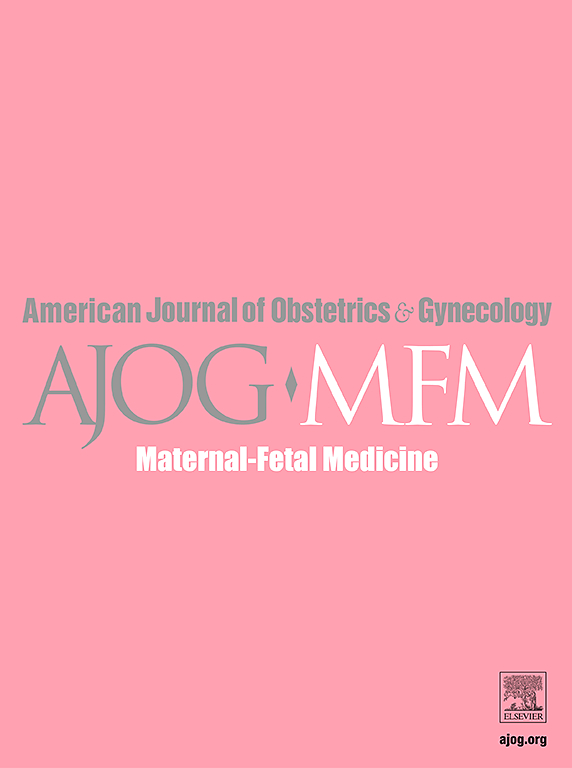Severe maternal morbidity and risk of transplant rejection in pregnant patients with a history of solid-organ transplant
IF 3.1
2区 医学
Q1 OBSTETRICS & GYNECOLOGY
American Journal of Obstetrics & Gynecology Mfm
Pub Date : 2025-05-10
DOI:10.1016/j.ajogmf.2025.101696
引用次数: 0
Abstract
Background
In 2023, 18,078 US women underwent solid organ transplants; over a third (n = 5547) were of reproductive age, receiving kidney (69.6%), liver (23.7%), or heart (9.0%) transplants. Successful pregnancies are feasible for transplant recipients, but these patients often face elevated pregnancy risks, including hypertension, gestational diabetes, pre-eclampsia, and preterm birth.
Objective
To determine rates of severe maternal morbidity (SMM) associated with prior kidney, liver, or heart transplant.
Study Design
This descriptive study was conducted using the TriNetX Research Network, a health research network with data from 95 health care organizations spanning 1/1/2010−10/29/2024. Patients aged 12-55 years were included if they underwent single solid organ transplant prior to pregnancy and had no prior history of transplant rejection. Pregnancy was defined by delivery CPT code indicating presence of a pregnancy. SMM was defined using Centers for Disease Control (CDC) ICD-10 codes for 21 indicators of SMM. The primary outcome was composite SMM during delivery hospitalization or within one year postpartum. Secondary outcomes included comparison of SMM in individuals with and without solid organ transplant history, as well as estimation of rates of individual indicators of SMM and postpartum transplant rejection over time.
Results
A total of 421 kidney, 192 liver, and 59 heart transplant recipients met inclusion criteria. Rates of composite SMM were greatest for heart transplant recipients (40.7%), with morbidity most often from pulmonary edema/acute heart failure (28.8%). This was followed by kidney transplant recipients (composite SMM 11.48%), with acute renal failure occurring in 9% of patients. Liver transplant recipients had the lowest composite SMM (7.48%). Rates of postpartum solid organ transplant rejection progressively increased at 1-, 2-, and 5-years post-delivery for all cohorts. Solid organ transplant rejection at 5-years was highest for heart transplant recipients (25.4%), followed by kidney (11.48%), and liver (7.48%).
Conclusion
Solid organ transplant recipients have significantly higher odds of composite SMM compared to pregnant non-transplant recipients. Among transplant recipients, patients with a history of heart transplant had the highest prevalence of composite non-transfusion SMM and highest rates of transplant rejection 5 years post-delivery. The impact of pregnancy on long-term outcomes in transplant recipients requires further study.
有实体器官移植史的孕妇的严重产妇发病率和移植排斥风险。
背景:2023年,18078名美国女性接受了实体器官移植;超过三分之一(n=5547)处于育龄,接受肾脏(69.6%)、肝脏(23.7%)或心脏(9.0%)移植。移植受者成功妊娠是可行的,但这些患者往往面临妊娠风险升高,包括高血压、妊娠糖尿病、先兆子痫和早产。目的:确定与既往肾、肝或心脏移植相关的严重产妇发病率(SMM)。研究设计:本描述性研究使用TriNetX研究网络进行,该网络是一个健康研究网络,收集了2010年1月1日至2024年10月29日期间95个卫生保健组织的数据。年龄在12-55岁的患者如果在怀孕前接受过单一实体器官移植,并且没有移植排斥史。怀孕是由分娩CPT代码定义的,表明怀孕的存在。SMM的定义采用美国疾病控制与预防中心(CDC) ICD-10编码,包含SMM的21项指标。主要终点是分娩住院期间或产后一年内的综合SMM。次要结局包括比较有和没有实体器官移植史的个体的SMM,以及估计SMM的个体指标率和产后移植排斥反应随时间的变化。结果:共有421例肾脏、192例肝脏和59例心脏移植受者符合纳入标准。心脏移植受者的复合SMM发生率最高(40.7%),最常见的发病率是肺水肿/急性心力衰竭(28.8%)。其次是肾移植受者(复合SMM 11.48%), 9%的患者发生急性肾功能衰竭。肝移植受者的综合SMM最低(7.48%)。在所有队列中,产后实体器官移植排斥率在分娩后1、2和5年逐渐增加。5年实体器官移植排斥反应最高的是心脏移植(25.4%),其次是肾脏(11.48%)和肝脏(7.48%)。结论:实体器官移植受者复合SMM发生率明显高于妊娠未移植受者。在移植受者中,有心脏移植史的患者产后5年复合非输血SMM患病率最高,移植排斥率最高。妊娠对移植受者长期预后的影响需要进一步研究。
本文章由计算机程序翻译,如有差异,请以英文原文为准。
求助全文
约1分钟内获得全文
求助全文
来源期刊

American Journal of Obstetrics & Gynecology Mfm
Medicine-Medicine (all)
CiteScore
7.40
自引率
3.20%
发文量
254
审稿时长
40 days
期刊介绍:
The American Journal of Obstetrics and Gynecology (AJOG) is a highly esteemed publication with two companion titles. One of these is the American Journal of Obstetrics and Gynecology Maternal-Fetal Medicine (AJOG MFM), which is dedicated to the latest research in the field of maternal-fetal medicine, specifically concerning high-risk pregnancies. The journal encompasses a wide range of topics, including:
Maternal Complications: It addresses significant studies that have the potential to change clinical practice regarding complications faced by pregnant women.
Fetal Complications: The journal covers prenatal diagnosis, ultrasound, and genetic issues related to the fetus, providing insights into the management and care of fetal health.
Prenatal Care: It discusses the best practices in prenatal care to ensure the health and well-being of both the mother and the unborn child.
Intrapartum Care: It provides guidance on the care provided during the childbirth process, which is critical for the safety of both mother and baby.
Postpartum Issues: The journal also tackles issues that arise after childbirth, focusing on the postpartum period and its implications for maternal health. AJOG MFM serves as a reliable forum for peer-reviewed research, with a preference for randomized trials and meta-analyses. The goal is to equip researchers and clinicians with the most current information and evidence-based strategies to effectively manage high-risk pregnancies and to provide the best possible care for mothers and their unborn children.
 求助内容:
求助内容: 应助结果提醒方式:
应助结果提醒方式:


